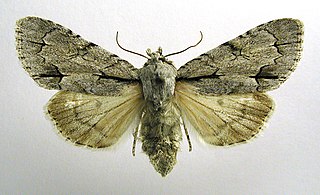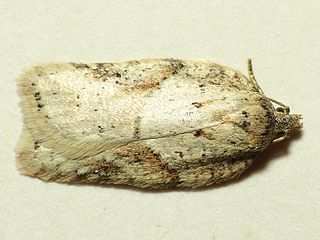Related Research Articles

The dot moth is a moth of the family Noctuidae. The species was first described by Carl Linnaeus in 1761. It is a very distinctive species with very dark brown, almost black, forewings marked with a large white stigma from which the species gets its common name. The hindwings are grey with a dark band at the termen. The wingspan is 38–50 mm. It flies at night in July and August and is attracted to light, sugar and flowers.

The grey chi is a moth of the family Noctuidae. The species was first described by Carl Linnaeus in his 1758 10th edition of Systema Naturae. It is distributed throughout Europe, although it is not present in southern Spain and Greece, as well as northern Fennoscandia. It is also found across the Palearctic including Central Asia, to the Russian Far East but not in Japan.

The dark dagger is a moth of the family Noctuidae. The species was first described by Michael Denis and Ignaz Schiffermüller in 1775. It is distributed throughout Europe, Turkey, the Near East, the European part of Russia, southern Siberia, the Ural, the Russian Far East, the Korean Peninsula, China and Japan (Hokkaido).

Angerona is a monotypic moth genus in the family Geometridae erected by Philogène Auguste Joseph Duponchel in 1829. Its only species, Angerona prunaria, the orange moth, was first described by Carl Linnaeus in his 1758 10th edition of Systema Naturae.

Acronicta cuspis, the large dagger, is a moth of the family Noctuidae. It is distributed through most of Europe, Northern Africa (Morocco), the European part of Russia, the Caucasus, the Russian Far East, southern Siberia, Transcaucasia, central Asia, China, Japan and the Korean Peninsula.

Acronicta menyanthidis, the light knot grass, is a moth of the family Noctuidae. It is distributed through northern, central and eastern Europe, east to Siberia and the Russian Far East.

Orthosia incerta, the clouded drab, is a species of moth of the family Noctuidae, found in Europe and Asia. The occurrence of the species extends through all European countries through the Palearctic to the Russian Far East and Japan. It is absent from northern Fennoscandia and in the Alps it occurs up to 2000 m above sea level.

Lygephila pastinum, the blackneck, is a moth of the family Erebidae. The species was first described by Georg Friedrich Treitschke in 1826. It is found in Europe and across the Palearctic Siberia, the Russian Far East, Japan and China.

Celypha cespitana is a moth of the family Tortricidae. It is found in the Palearctic realm, from western Europe to the Ural Mountains, Transcaucasia, Asia Minor, the Near East, Iran, Russia, north-eastern China (Manchuria), Korea and Japan. It is also found in the Nearctic realm.

Achlya flavicornis, the yellow horned, is a moth of the family Drepanidae. The species was first described by Carl Linnaeus in his 1758 10th edition of Systema Naturae. It is found from Europe to the eastern Palearctic ecozone.

Mythimna obsoleta, the obscure wainscot, is a moth of the family Noctuidae. The species was first described by Jacob Hübner in 1803. It is found in Europe, from southern Fennoscandia to Spain, Italy and the Balkans, the European part of Russia, the Caucasus, Kazakhstan, Kyrgyzia, southern Siberia, Turkey, the Ural, Mongolia, the Russian Far East, the Korean Peninsula, China and Hokkaido and Honshu in Japan.

Athrips mouffetella is a moth of the family Gelechiidae. It is found from central and northern Europe to the Ural Mountains, Siberia and the Russian Far East. It has also been recorded from North America.

Lyonetia clerkella, the apple leaf miner, is a moth in the family Lyonetiidae. It is found all over Europe, north-western Siberia, the Far East, northern Africa, the Middle East, Turkey, India and Japan.

Denticucullus pygmina, the small wainscot, is a moth of the family Noctuidae. It is found in most of Europe, ranging from northern Spain, through Portugal as far north as Finland. In the east it is found across the Palearctic to the Russian Far East and western Siberia. It is also found in North Africa, Turkey, the Caucasus region and northern Iran.
Bucculatrix maritima is a species of moth of the family Bucculatricidae. It is found in most of Europe, Russia and Japan. It was first described in 1851 by Henry Tibbats Stainton.

Carpatolechia fugitivella, the elm groundling, is a moth of the family Gelechiidae. It is found in almost all of Europe, Turkey, the Caucasus, Mongolia, southern Siberia, the Russian Far East and Korea. It is also found in Canada, where it has been recorded from Ontario and Quebec. The habitat consists of woodland, parks, gardens and hedgerows.

Acleris logiana, the black-headed birch leaffolder moth or grey birch button, is a moth of the family Tortricidae. It was described by Carl Alexander Clerck in 1759. It is found in most of Europe, except Ireland, Portugal, most of the Balkan Peninsula and Ukraine. It is also found in North America, the Russian Far East, Korea and Japan.
Neoploca is a genus of moths belonging to the subfamily Thyatirinae of the Drepanidae. It was first described by Shōnen Matsumura in 1927. It contains only one species, Neoploca arctipennis, first described by Arthur Gardiner Butler in 1878, which is found in Japan, Korea, the Russian Far East and China.
Neofaculta confidella is a moth in the family Gelechiidae. It was described by Rebel in 1936. It is found in south-eastern Turkey, Iraq and northern Syria.
Monochroa leptocrossa is a moth of the family Gelechiidae. It was described by Edward Meyrick in 1926. It is found on the Japanese island of Hokkaido and in the Russian Far East. This species has been introduced to New Zealand. Lepidoptera and Some Other Life Forms gives this name as a synonym of Monochroa hornigi.